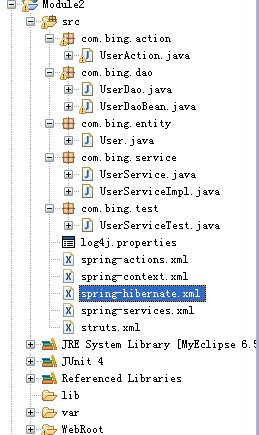该架构是设计的第二个架构,和第一个不同的是,采用了AOP事务管理方式,代码如下:
<?xml version="1.0" encoding="GBK"?><beans xmlns="http://www.springframework.org/schema/beans" xmlns:xsi="http://www.w3.org/2001/XMLSchema-instance" xmlns:aop="http://www.springframework.org/schema/aop" xmlns:tx="http://www.springframework.org/schema/tx" xmlns:lang="http://www.springframework.org/schema/lang" xsi:schemaLocation=" http://www.springframework.org/schema/beans http://www.springframework.org/schema/beans/spring-beans-2.0.xsd http://www.springframework.org/schema/lang http://www.springframework.org/schema/lang/spring-lang-2.0.xsd http://www.springframework.org/schema/tx http://www.springframework.org/schema/tx/spring-tx.xsd http://www.springframework.org/schema/aop http://www.springframework.org/schema/aop/spring-aop.xsd"> <!-- 采用bean方式配置数据源和sessionfactory --> <bean id="sessionFactory" class="org.springframework.orm.hibernate3.annotation.AnnotationSessionFactoryBean"> <property name="hibernateProperties" ref="hibernateProperties" /> <property name="dataSource" ref="dataSource" /> <!-- <property name="configLocation"> <value>classpath:hiberante.cfg.xml</value> </property> --> <property name="packagesToScan"> <list> <value>com.bing.entity</value> </list> </property> </bean> <bean id="dataSource" class="org.apache.commons.dbcp.BasicDataSource" destroy-method="close"> <property name="driverClassName" value="com.mysql.jdbc.Driver" /> <property name="url" value="jdbc:mysql://localhost:3306/ssh2" /> <property name="username" value="root" /> <property name="password" value="123456" /> </bean> <bean id="transactionManager" class="org.springframework.orm.hibernate3.HibernateTransactionManager"> <property name="sessionFactory" ref="sessionFactory" /> </bean><!-- 采用AOP(面向方面编程)方式配置事物 --> <tx:advice id="txAdvice" transaction-manager="transactionManager"> <tx:attributes> <tx:method name="save*" propagation="REQUIRED" /> <tx:method name="delete*" propagation="REQUIRED" /> <tx:method name="update*" propagation="REQUIRED" /> <tx:method name="*" read-only="true"/> </tx:attributes> </tx:advice> <!-- 哪些类的哪些方法参与事物, (* com.evan.crm.service.*.*(..))中几个通配符的含义: 第一个 * —— 通配 任意返回值类型 第二个 * —— 通配 包com.evan.crm.service下的任意class 第三个 * —— 通配 包com.evan.crm.service下的任意class的任意方法 第四个 .. —— 通配 方法可以有0个或多个参数 综上:包com.evan.crm.service下的任意class的具有任意返回值类型、任意数目参数和任意名称的方法--> <aop:config> <aop:pointcut id="allManagerMethod" expression="execution(* com.bing.dao.*.*(..))" /> <aop:advisor pointcut-ref="allManagerMethod" advice-ref="txAdvice" /> </aop:config> <!-- Clob 类型处理配置 BEGIN --> <bean id="defaultLobHandler" lazy-init="true" class="org.springframework.jdbc.support.lob.DefaultLobHandler" /> <!-- hibernate 基本配置 --> <bean id="hibernateProperties" class="org.springframework.beans.factory.config.PropertiesFactoryBean"> <property name="properties"> <props> <prop key="hibernate.connection.charSet">UTF-8</prop> <prop key="hibernate.show_sql">true</prop> <prop key="hibernate.dialect"> org.hibernate.dialect.MySQLDialect </prop> <prop key="hibernate.hbm2ddl.auto">update</prop> </props> </property> </bean></beans>
?
文件夹分布图:
?
?
在文件结构上,和Module1并无太大区别,区别就在spring-hibernate.xml文件中,即上面贴出的代码中。并且采用的是AnnotationSessionFactoryBean管理OR实体映射,省去了编写配置文件的问题。
附件地址:
http://download.csdn.net/source/3014114